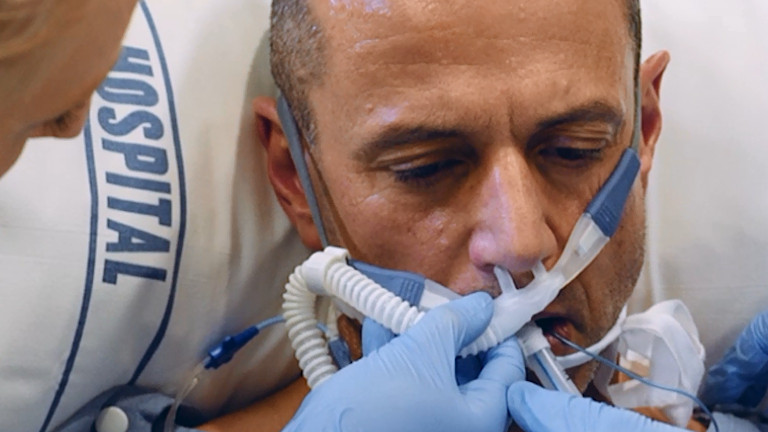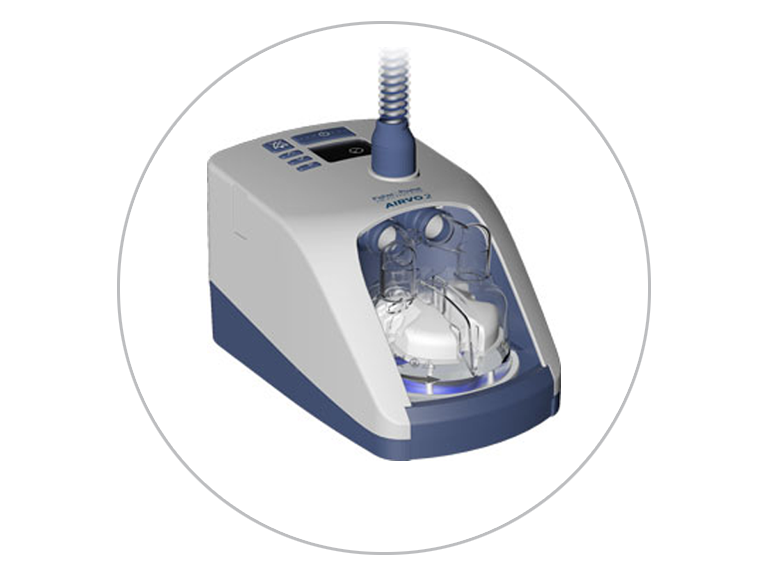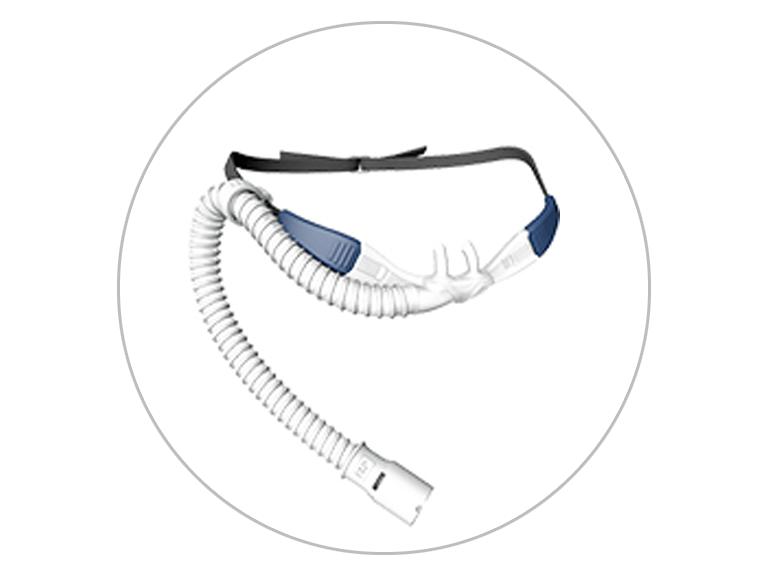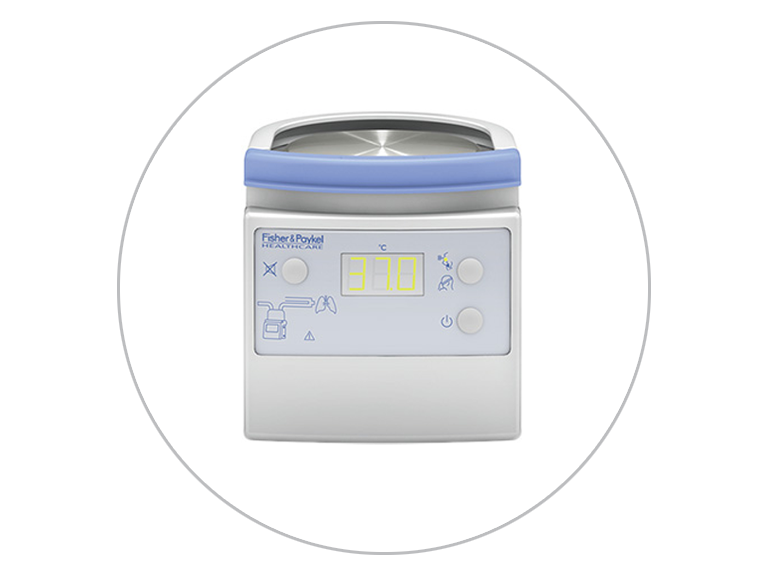Usando Optiflow para reduzir on escalonamento do cuidado dos pacientes
HFNC, HFOT, NHF, HF...
O Alto Fluxo Nasal Optiflow da Fisher & Paykel Healthcare, está na liderança global sendo mencionado em
centenas de publicações e em periódicos de grande prestígio, como o NEJM e o JAMA.
“O uso de Alto Fluxo Nasal reduziu o risco de reintubação em até 72 horas.”
(em pacientes extubados com baixo risco de reintubação).
“O Alto Fluxo Nasal reduziu significativamente a necessidade de intubação para pacientes mais agudos.”
(em comparação com O2 convencional e VNI, PaO2:FiO2 ≤ 200 mmHg).
“NHF foi não inferior à pressão positiva de dois níveis nas vias aéreas para insucesso no tratamento.”
(em pacientes extubados pós-cirurgia cardíaca).
Como o Optiflow funciona?
Os mecanismos de ação
Com o Alto Fluxo Nasal Optiflow, você pode titular independentemente o fluxo e a FiO2, de acordo com a necessidade do paciente.’ Os mecanismos de ação são diferentes dos mecanismos de terapias convencionais, assim como os efeitos fisiológicos resultantes e os resultados clínicos.
Os mecanismos de ação do Alto Fluxo Nasal Optiflow são:
- Suporte respiratório (por meio da redução do espaço morto
e administração de uma pressão positiva dinâmica nas vias aéreas) - Hidratação das vias aéreas
- Conforto do paciente
- Oxigênio suplementar (se necessário)
Esses mecanismos contribuem com efeitos fisiológicos, como frequência respiratória reduzida, melhora da oxigenação, níveis reduzidos de dióxido de carbono e melhora na depuração do muco.
Obs: os mecanismos de ação para alto fluxo nasal acima se aplicam ao fornecimento através de uma interface da cânula nasal Optiflow. Os mecanismos de ação diferem quando alto fluxo é fornecido através de uma traqueostomia ou de um adaptador para máscara.
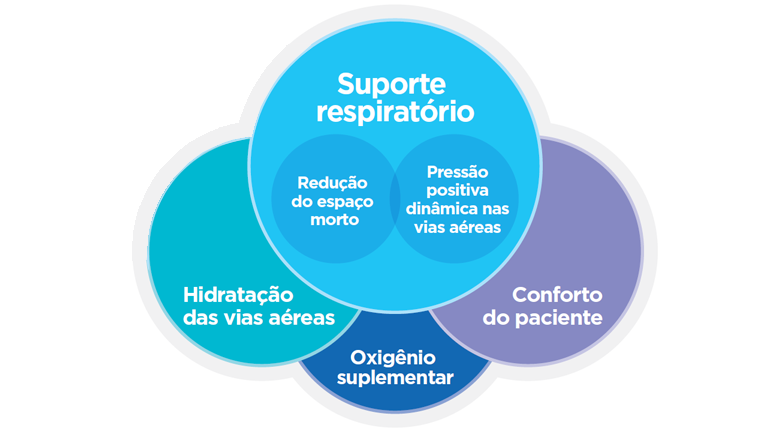
Extubação para
terapia NHF Optiflow
Este vídeo mostra a extubação para a terapia de Alto Fluxo Nasal Optiflow e se baseia no procedimento usado pelo Dr. Hernández e colegas' nos estudos abaixo:
1. Hernández et al. JAMA. 2016 (Abril) e
2. Hernández et al. JAMA. 2016 (Out.)
Tecnologia Optiflow
A tecnologia da Fisher & Paykel Healthcare foi a primeira escolha de estudos importantes publicados
no NEJM e no JAMA, garantindo o lugar do Optiflow na liderança dessa interessante terapia.
Sistema Airvo™ 2
A um fluxo de 2 a 60 L/min, Airvo 2 é um sistema de alto fluxo nasal autônomo que pode ser usado durante os cuidados continuados, desde o PS e a UTI até a enfermaria e para casa.
NOVO Cânula nasal Optiflow™ Duet
Sistema MR850
O umidificador MR850 é usado para uma ampla gama de terapias da Fisher & Paykel Healthcare no F&P Respiratory Care Continuum™.
Averiguação sobre a avaliação do Optiflow
Se você tiver alguma dúvida sobre nossos produtos, forneça as seguintes informações para que um representante da Fisher & Paykel Healthcare possa contatá-lo. Para obter mais detalhes sobre como essas informações serão utilizadas, veja abaixo ou acesse nossa declaração de privacidade.Referências
- Frat JP, Thille AW, Mercat A, Girault C, Ragot S, Perbet S et al. High-Flow Oxygen through Nasal Cannula in Acute Hypoxemic Respiratory Failure. N Engl J Med. 2015;372(23):2185–96.
- Hernández G, Vaquero C, González P, Subira C, Frutos-Vivar F, Rialp G et al. Effect of Postextubation High-Flow Nasal Cannula vs Conventional Oxygen Therapy on Reintubation in Low-Risk Patients: A Randomized Clinical Trial. JAMA. (Abr) 2016; 315(13):1354–61.
- Stéphan F, Barrucand B, Petit P, Rézaiguia-Delclaux S, Médard A, Delannoy B et al. High-Flow Nasal Oxygen vs Noninvasive Positive Airway Pressure in Hypoxemic Patients After Cardiothoracic Surgery: A Randomized Clinical Trial. JAMA. 2015; 13(23):2331–9.
Redução da frequência respiratória
- Sztrymf B, Messika J, Bertrand F, Hurel D, Leon R, Dreyfuss D et al. Beneficial effects of humidified high flow nasal oxygen in critical care patients: a prospective pilot study. Intensive Care Med. 2011; 37(11):1780–6.
- Corley A, Caruana LR, Barnett AG, Tronstad O, Fraser JF. Oxygen delivery through high-flow nasal cannulae increase end-expiratory lung volume and reduce respiratory rate in post-cardiac surgical patients. Br J Anaesth. 2011; 107(6):998–1004.
- Roca O, Riera J, Torres F, Masclans JR. High-Flow Oxygen Therapy in Acute Respiratory Failure. Respir Care. 2010; 55(4):408–13
- Lenglet H, Sztrymf B, Leroy C, Brun P, Dreyfuss D, Ricard JD. Humidified High Flow Nasal Oxygen During Respiratory Failure in the Emergency Department: Feasibility and Efficacy. Respir Care. 2012; 57(11):1873–8.
- Rittayamai N, Tscheikuna J, Rujiwit P. High-Flow Nasal Cannula Versus Conventional Oxygen Therapy After Endotracheal Extubation: A Randomized Crossover Physiologic Study. Respir Care. 2014; 59(4): 485–90.
- Roca O, Pérez-Terán P, Masclans JR, Pérez L, Galve E, Evangelista A et al. Patients with New York Heart Association class III heart failure may benefit with high flow nasal cannula supportive therapy: High flow nasal cannula in heart failure. J Crit Care. 2013; 28(5):741–6.
- Peters S, Holets S, Gay P. High-Flow Nasal Cannula Therapy in Do-Not-Intubated Patients with Hypoxemic Respiratory Distress. Respir Care. 2013; 58(4): 597-600.
Improved oxygenation
- Ritchie JE, Williams AB, Gerard C, Hockey H. Evaluation of a humidified nasal high flow oxygen system, using oxygraphy, capnography and measurement of upper airway pressures. Anaesth Intensive Care. 2011; 39(6):1103–10.
- Masclans JR, Roca O. High-Flow Oxygen Therapy in Acute Respiratory Failure. Clin Pulm Med. 2012; 19(3):127–30.
- Peters S, Holets S, Gay P. High-Flow Nasal Cannula Therapy in Do-Not-Intubated Patients with Hypoxemic Respiratory Distress. Respir Care. 2013; 58(4): 597–600.
- Sztrymf B, Messika J, Bertrand F, Hurel D, Leon R, Dreyfuss D et al. Beneficial effects of humidified high flow nasal oxygen in critical care patients: a prospective pilot study. Intensive Care Med. 2011; 37(11):1780–6.
- Corley A, Caruana LR, Barnett AG, Tronstad O, Fraser JF. Oxygen delivery through high-flow nasal cannulae increase end-expiratory lung volume and reduce respiratory rate in post-cardiac surgical patients. Br J Anaesth. 2011; 107(6):998–1004.
- Roca O, Riera J, Torres F, Masclans JR. High-Flow Oxygen Therapy in Acute Respiratory Failure. Respir Care. 2010; 55(4):408–13.
- Lucangelo U, Vassallo FG, Marras E, Ferluga M, Beziza E, Comuzzi L et al. High-Flow Nasal Interface Improves Oxygenation in Patients Undergoing Bronchoscopy. Crit Care Res Pract. 2012; (12):1–6.
Reduced carbon dioxide levels
- Möller W, Celik G, Feng S, Bartenstein P, Meyer G, Eickelberg O et al. Nasal high flow clears anatomical deadspace in upper airway models. J Appl Physiol. 2015; 118:1525–32.
- Mündel T, Feng S, Tatkov S, Schneider H. Mechanisms of nasal high flow on ventilation during wakefulness and sleep. J Appl Physiol. 2013; 114:1058–65.
- Jeong JH, Kim DH, Kim SC, Kang C, Lee SH, Kang TS et al. Changes in arterial blood gases after use of high-flow nasal cannula therapy in the ED. Am J Emerg Med. 2015;3(10):1344–9.
Improved mucus clearance
- Hasani A, Chapman TH, McCool D, Smith RE, Dilworth JP, Agnew JE. Domiciliary humidification improves lung mucociliary clearance in patients with bronchiectasis. Chron Respir Dis. 2008; 5(2):81–6.
Decreased escalation of care
- Frat JP, Thille AW, Mercat A, Girault C, Ragot S, Perbet S et al. High-Flow Oxygen through Nasal Cannula in Acute Hypoxemic Respiratory Failure. N Engl J Med. 2015;372(23):2185–96.
- Hernández G, Vaquero C, González P, Subira C, Frutos-Vivar F, Rialp G et al. Effect of Postextubation High-Flow Nasal Cannula vs Conventional Oxygen Therapy on Reintubation in Low-Risk Patients: A Randomized Clinical Trial. JAMA. (Abr) 2016; 315(13):1354–61.
- Hernández G, Vaquero C, Colinas L, Cuena R, González P, Canabal A et al. Effect of Postextubation High-Flow Nasal Cannula vs Noninvasive Ventilation on Reintubation and Postextubation Respiratory Failure in High-Risk Patients. JAMA. (Out) 2016; 316(15):1565–74.
- Stéphan F, Barrucand B, Petit P, Rézaiguia-Delclaux S, Médard A, Delannoy B et al. High-Flow Nasal Oxygen vs Noninvasive Positive Airway Pressure in Hypoxemic Patients After Cardiothoracic Surgery: A Randomized Clinical Trial. JAMA. 2015; 13(23):2331-9.
Reduced mortality rates
- Frat JP, Thille AW, Mercat A, Girault C, Ragot S, Perbet S et al. High-Flow Oxygen through Nasal Cannula in Acute Hypoxemic Respiratory Failure. N Engl J Med. 2015;372(23):2185–96.
Improved symptomatic relief
- Frat JP, Thille AW, Mercat A, Girault C, Ragot S, Perbet S et al. High-Flow Oxygen through Nasal Cannula in Acute Hypoxemic Respiratory Failure. N Engl J Med. 2015;372(23):2185–96.
- Roca O, Riera J, Torres F, Masclans JR. High-Flow Oxygen Therapy in Acute Respiratory Failure. Respir Care. 2010; 55(4):408-13.
- Lenglet H, Sztrymf B, Leroy C, Brun P, Dreyfuss D, Ricard JD. Humidified High Flow Nasal Oxygen During Respiratory Failure in the Emergency Department: Feasibility and Efficacy. Respir Care. 2012; 57(11):1873-8
- Frat JP, Thille AW, Mercat A, Girault C, Ragot S, Perbet S et al. High-Flow Oxygen through Nasal Cannula in Acute Hypoxemic Respiratory Failure. N Engl J Med. 2015;372(23):2185–96.
- Hernández G, Vaquero C, González P, Subira C, Frutos-Vivar F, Rialp G et al. Effect of Postextubation High-Flow Nasal Cannula vs Conventional Oxygen Therapy on Reintubation in Low-Risk Patients: A Randomized Clinical Trial. JAMA. (Abr) 2016; 315(13):1354–61.
- Hernández G, Vaquero C, Colinas L, Cuena R, González P, Canabal A et al. Effect of Postextubation High–Flow Nasal Cannula vs Noninvasive Ventilation on Reintubation and Postextubation Respiratory Failure in High–Risk Patients. JAMA. (Out) 2016; 316(15):1565–74.

